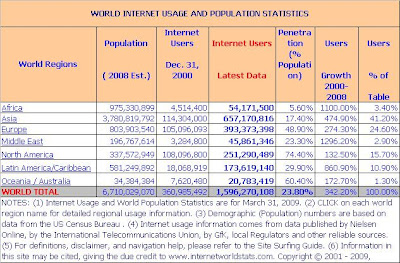
The rules of the internet conquest will have to change and will require some fundamental re-thinking of re-packaging the delivery. Here are a few pointers towards the new rules of the game:
1.English got Internet, where it is today, but going forward, English may be limiting. It is not hard to associate a higher penetration of internet with the English world (North America, Western Europe and Australia).
This thus places emphasis on language of internet delivery: Mandarin, Hindi, Malaya, Tamil, Urdu, Swahili and more. English literacy will not drive economic and human development in these states. The mode of deliverance will be the local language.
Penetration in the second and third wave states, will depend on Telecom penetration and hence the mobile phone/handheld devices will become the harbingers of the internet revolution. By handhelds, I do not mean the fancy up-market smart-phones but basic $40/60 phones.
3.Existing subscription or ad based models may not be useful for these emerging markets. Revenue, Profitability and Sustainability models find the internet business space to be extremely slippery even in English speaking regions where culture, usages and habits are somewhat contiguous.
For the second and third wave states, customization to language, habits, cultures, money usage, and payment mechanisms will pose a significant challenge to marketers.
Device limitations will influence content delivery. Content focus has to be sharp and light. One will have to judiciously use the knowledge of the local markets, mix them up smartly with business objectives and keep the content sharp and focused. Content delivery will also be a critical variable. Keeping in mind the infrastructural shortcomings, content delivered may only be uni-dimensional in nature (only voice or only text).
The challenge is to cater to the basic needs of the population better. The delivery medium here has to be much broader and involve more public utilities, health services, department of posts, Agriculture and Labour ministries or groups, banking groups etc. This involves a re-defining of the eco-system of delivery.
6.The problem of platforms, browsers and OSs is a vexing one even in the age of computing devices. The adaptabilities and compatibilities will be another challenge when the medium of delivery shifts to a basic phone.
Thus the delivery medium needs to be platform agnostic and will sit on a server preceding the mobile phone in the value delivery chain. For eg. a server that processes a consumer request, links up to the relevant website/portal, accesses information, downloads it on itself and then plays it back to the user after customizing the content. (Eg. The server receives a weather update, visits the local meteorological department portal, downloads data, coverts it into local language text/voice and plays it back to the user.)
The Second and third wave user is a very cautious spender and frugal as well. He does not own credit cards and the payment mechanism will have to involve the Telecom Operator. Such tie-ups would be critical in bringing internet enabled access to the user. There is a space for MVNEs and MVNAs playing a meaningful role here connecting the Solution provider, Telecom operator, Finance provider, Systems provider etc.
Internet Marketers are yet to meet the real challenge of deep penetration in the Asian and African markets, and the pointers given above would be critical for building sustainable depth.

 It might point to the fact that content produced by Men on twitter is perceived to be more compelling than a typical social network and content produced by women is less compelling (because of lack of photo sharing, detailed biographies etc)
It might point to the fact that content produced by Men on twitter is perceived to be more compelling than a typical social network and content produced by women is less compelling (because of lack of photo sharing, detailed biographies etc) At the same time there is a small contingent of users who are very active. Specifically, the top 10% of prolific Twitter users accounted for over 90% of tweets. On a typical online social network, the top 10% of users account for 30% of all production. To put Twitter in perspective, consider an unlikely analogue - Wikipedia. There, the top 15% of the most prolific editors account for 90% of Wikipedia's edits ii. In other words, the pattern of contributions on Twitter is more concentrated among the few top users than is the case on Wikipedia, even though Wikipedia is clearly not a communications tool. This implies that Twitter's resembles more of a one-way, one-to-many publishing service more than a two-way, peer-to-peer communication network.
At the same time there is a small contingent of users who are very active. Specifically, the top 10% of prolific Twitter users accounted for over 90% of tweets. On a typical online social network, the top 10% of users account for 30% of all production. To put Twitter in perspective, consider an unlikely analogue - Wikipedia. There, the top 15% of the most prolific editors account for 90% of Wikipedia's edits ii. In other words, the pattern of contributions on Twitter is more concentrated among the few top users than is the case on Wikipedia, even though Wikipedia is clearly not a communications tool. This implies that Twitter's resembles more of a one-way, one-to-many publishing service more than a two-way, peer-to-peer communication network.














 7.Symbian accounted for 49.3 per cent of worldwide smartphone operating systems (OS) market share in the first quarter of 2009, down from 56.9 per cent share in the first quarter of 2008.
7.Symbian accounted for 49.3 per cent of worldwide smartphone operating systems (OS) market share in the first quarter of 2009, down from 56.9 per cent share in the first quarter of 2008.
.jpg)
.jpg)

.jpg)

.jpg)




